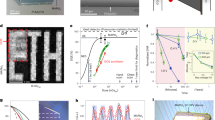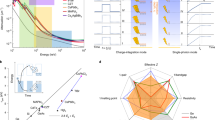Abstract
Medical X-ray imaging procedures require digital flat detectors operating at low doses to reduce radiation health risks1,2. Solution-processed organic–inorganic hybrid perovskites have characteristics that make them good candidates for the photoconductive layer of such sensitive detectors3,4,5,6,7. However, such detectors have not yet been built on thin-film transistor arrays because it has been difficult to prepare thick perovskite films (more than a few hundred micrometres) over large areas (a detector is typically 50 centimetres by 50 centimetres). We report here an all-solution-based (in contrast to conventional vacuum processing) synthetic route to producing printable polycrystalline perovskites with sharply faceted large grains having morphologies and optoelectronic properties comparable to those of single crystals. High sensitivities of up to 11 microcoulombs per air KERMA of milligray per square centimetre (μC mGyair−1 cm−2) are achieved under irradiation with a 100-kilovolt bremsstrahlung source, which are at least one order of magnitude higher than the sensitivities achieved with currently used amorphous selenium or thallium-doped cesium iodide detectors. We demonstrate X-ray imaging in a conventional thin-film transistor substrate by embedding an 830-micrometre-thick perovskite film and an additional two interlayers of polymer/perovskite composites to provide conformal interfaces between perovskite films and electrodes that control dark currents and temporal charge carrier transportation. Such an all-solution-based perovskite detector could enable low-dose X-ray imaging, and could also be used in photoconductive devices for radiation imaging, sensing and energy harvesting.
This is a preview of subscription content, access via your institution
Access options
Access Nature and 54 other Nature Portfolio journals
Get Nature+, our best-value online-access subscription
$29.99 / 30 days
cancel any time
Subscribe to this journal
Receive 51 print issues and online access
$199.00 per year
only $3.90 per issue
Buy this article
- Purchase on Springer Link
- Instant access to full article PDF
Prices may be subject to local taxes which are calculated during checkout




Similar content being viewed by others
References
Brenner, D. J. & Hall, E. J. Computed tomography: an increasing source of radiation exposure. N. Engl. J. Med. 357, 2277–2284 (2007)
Sinnott, B., Ron, E. & Schneider, A. B. Exposing the thyroid to radiation: a review of its current extent, risks, and implications. Endocr. Rev. 31, 756–773 (2010)
Yakunin, S. et al. Detection of X-ray photons by solution-processed lead halide perovskites. Nature Photon. 9, 444–449 (2015)
Wei, H. et al. Sensitive X-ray detectors made of methylammonium lead tribromide perovskite single crystals. Nat. Photon. 10, 333–339 (2016)
Yakunin, S. et al. Detection of gamma photons using solution-grown single crystals of hybrid lead halide perovskites. Nat. Photon. 10, 585–589 (2016)
Wei, W. et al. Monolithic integration of hybrid perovskite single crystals with heterogenous substrate for highly sensitive X-ray imaging. Nat. Photon. 11, 315–321 (2017)
Shrestha, S. et al. High-performance direct conversion X-ray detectors based on sintered hybrid lead triiodide perovskite wafers. Nat. Photon. 11, 436–440 (2017)
Kojima, A. et al. Organometal halide perovskites as visible-light sensitizers for photovoltaic cells. J. Am. Chem. Soc. 131, 6050–6051 (2009)
Lee, M. et al. Efficient hybrid solar cells based on meso-superstructured organometal halide perovskites. Science 338, 643–647 (2012)
Zentai, G. et al. Detailed imager evaluation and unique applications of a new 20 cm × 25 cm size mercuric iodide thick film X-ray detector. Proc. SPIE 5047, 84–95 (2003)
Choquette, M. et al. Direct selenium X-ray detector for fluoroscopy, R&F, and radiography. Proc. SPIE 3977, 128–136 (2000)
Berger, M. J. XCOM Photon Cross Sections Database https://www.nist.gov/pml/xcom-photon-cross-sections-database (NIST Phys. Lab., 1998)
Kasap, S. O. X-ray sensitivity of photoconductors: application to stabilized a-Se. J. Phys. D 33, 2853–2865 (2000)
Que, W. & Rowlands, J. A. X-ray photogeneration in amorphous selenium: geminate versus columnar recombination. Phys. Rev. B 51, 10500–10507 (1995)
Samei, E., Flynn, M. J. & Reimann, D. A. A method for measuring the presampled MTF of digital radiographic systems using an edge test device. Med. Phys. 25, 102–113 (1998)
Huang, J., Shao, Y. & Dong, Q. Organometal trihalide perovskite single crystals: a next wave of materials for 25% efficiency photovoltaics and applications beyond? J. Phys. Chem. Lett. 6, 3218–3227 (2015)
Deng, Y. et al. Scalable fabrication of efficient organoleadtrihalide perovskite solar cells with doctor-bladed active layers. Energy Environ. Sci. 8, 1544–1550 (2015)
Nie, W. et al. High-efficiency solution-processed perovskite solar cells with millimeter-scale grains. Science 347, 522–525 (2015)
Baikie, T. et al. Synthesis and crystal chemistry of the hybrid perovskite (CH3NH3)PbI3 for solid-state sensitised solar cell applications. J. Mater. Chem. A 1, 5628–5641 (2013)
Lian, Z. et al. High-performance planar-type photodetector on (100) facet of MAPbI3 single crystal. Sci. Rep. 5, 16563–16572 (2015)
Leguy, A. M. A. et al. Reversible hydration of CH3NH3PbI3 in films, single crystals, and solar cells. Chem. Mater. 27, 3397–3407 (2015)
Ahn, N. et al. Highly reproducible perovskite solar cells with average efficiency of 18.3% and best efficiency of 19.7% fabricated via Lewis base adduct of lead(II) iodide. J. Am. Chem. Soc. 137, 8696–8699 (2015)
Shi, D. et al. Low trap-state density and long carrier diffusion in organolead trihalide perovskite single crystals. Science 347, 519–522 (2015)
Wang, H., Huang, J., Xing, S. & Yu, J. Improved mobility and lifetime of carrier for highly efficient ternary polymer solar cells based on TIPS-pentacene in PTB7: PC71BM. Org. Electron. 28, 11–19 (2016)
Del Sordo, S. et al. Progress in the development of CdTe and CdZnTe semiconductor radiation detectors for astrophysical and medical applications. Sensors 9, 3491–3526 (2009)
Abbaszadeh, S. et al. Enhanced detection efficiency of direct conversion X-ray detector using polyimide as hole-blocking layer. Sci. Rep. 3, 3360–3366 (2013)
Galenko, P. K. et al. Dendritic solidification in undercooled Ni–Zr–Al melts: experiments and modeling. Acta Mater. 57, 6166–6175 (2009)
Zhao, W., DeCrescenzo, G. & Rowlands, J. A. Investigation of lag and ghosting in amorphous selenium flat-panel X-ray detectors. Proc. SPIE 4682, 9–20 (2002)
Buin, A. et al. Materials processing routes to trap-free halide perovskites. Nano Lett. 14, 6281–6286 (2014)
Pang, G., Zhao, W. & Rowlands, J. A. Digital radiology using active matrix readout of amorphous selenium: geometrical and effective fill factors. Med. Phys. 25, 1636–1646 (1998)
Acknowledgements
N.-G.P. acknowledges partial financial support from the National Research Foundation of Korea (NRF) grants funded by the Ministry of Science, ICT Future Planning (MSIP) of Korea under contracts NRF-2012M3A6A7054861 and NRF-2014M3A6A7060583 (Global Frontier R&D Program on Center for Multiscale Energy System) and NRF-2016M3D1A1027664 (Future Materials Discovery Program). Y.C.K., I.T.H. and S.Y.L. are indebted to all the members of SAIT (especially H. Kim and Y. Kim) and the Healthcare & Medical Equipment Division of Samsung Electronics (S. M. Yoon) for their help with the material characterization (SEM, X-ray diffraction, time-resolved photoluminescence and time-of-flight spectroscopy), X-ray detector fabrication, tape-automated bonding ROIC for the detector driving for its characterization, imaging processes and interpretation.
Author information
Authors and Affiliations
Contributions
I.T.H. initialized this project. Y.C.K. and N.-G.P. organized the collaboration. Y.S.C. and S.Y.L. planned and performed thermal and optoelectronic analysis. Y.C.K. and K.H.K. performed the synthesis of the MCP and PI-composites, and their analysis. D.-Y.S and D.-N.J. performed adduct film synthesis and analysis. D.-Y.S. and J.-Y.S. performed the impedance analysis. Y.C.K. and K.H.K. performed X-ray analysis, detector fabrication and imaging. Y.C.K., I.T.H. and N.G.P. wrote the manuscript. All authors discussed the results and commented on the manuscript.
Corresponding authors
Ethics declarations
Competing interests
The authors declare no competing financial interests.
Additional information
Reviewer Information Nature thanks J. A. Rowlands and the other anonymous reviewer(s) for their contribution to the peer review of this work.
Publisher's note: Springer Nature remains neutral with regard to jurisdictional claims in published maps and institutional affiliations.
Extended data figures and tables
Extended Data Figure 1 MPC X-ray detector.
a, Calculated mass attenuation coefficient for a-Se, CdZnTe and MAPbI3, and two normalized bremsstrahlung X-ray spectra used in medical applications as a function of X-ray energy. The linear attenuation coefficient (in cm−1) can be obtained by multiplying mass attenuation and mass density (a.u., arbitrary units). b, An X-ray spectrum of a 3-mm-filtered 100-kVp tungsten source in 1 mGyair (black line), the absorption by 830-μm-thick MPC film (blue line), and the resulting absorbed spectrum by the MPC film (red line). The integral of the absorbed spectrum equals the total deposited energy (Eabs) in the MPC film of about 2.91 × 1011 keV cm−2 mGyair−1. The W± is defined as EabsS−1, where S is the X-ray sensitivity. There are various loss mechanisms that reduce the sensitivity in the pixelated detector. Provided that all the specific loss factors are understood and corrected by further study, the panel sensitivities should coincide with those measured from simple diodes. At this stage this discrepancy is probably mainly due to the incomplete charge collection in the gap between pixels by the limited geometric fill factor‚ imperfect MPC contact on the pixel electrode, and a possible reduction in the effective applied bias on the MPC layer caused by the thicker interlayers formed in the processing of large-area detectors (rather than smaller diodes). c, The MTF of an MPC detector and a conventional a-Se direct converting detector with a same pixel pitch of 70 μm. The inset shows a magnified 100-kVp X-ray image of a resolution phantom. The MTF presented here was measured under 15 μGyair of dose (dose rate of 1.5 mGyair s−1 for 10 ms exposure time). d, A smartphone X-ray image at dose rate 1 mGyair s−1 with exposure time 10 ms (10 μGyair of dose).
Extended Data Figure 2 Optoelectronic properties of MPC film.
a, Photoluminescence spectra of the MPC and the thin adduct MAPbI3 film using an excitation source wavelength of 505 nm. b, Photoluminescence lifetime of the MPC film. The fitted recombination lifetime is 1.052 μs. c, Full time-of-flight current behaviour for both charge carriers: left for hole and right for electron. d, Nyquist plots of impedance (Z) spectra for the 400-μm-thick MPC film measured under 1 Sun and 0.1 Sun irradiation conditions. The inset shows the equivalent circuit for analysis, where Rs is the series resistance of the MPC, Rrec is the recombination resistance related to the recombination current, and CPE is the chemical capacitance represented as a constant phase element. Here, the lifetime is estimated by multiplying Rrec and CPE.
Extended Data Figure 3 Interlayers of PI–perovskite composites.
a, Additional images of interlayer films and their precursor solutions. Scale bar for the upper middle image, 30 μm. b, Morphology changes in PI-MAPbBr3 film with decreasing precursor concentration of MAPbBr3. All scale bars, 200 μm.
Extended Data Figure 4 Temporal X-ray response characterization.
a, Rise and fall time response dependent on the applied bias. b, ‘Lag’ measurement as a function of time after each X-ray pulse signal. c, ‘Ghosting’ measured using the sensitivity change for each X-ray pulse signal. Lag can be defined as [Idark(t) – Idark(0)]Sn−1, and ghosting as SnS1−1, where Idark(t) is the dark current measured at time t after each exposure, Idark(0) is the initial dark current level before any exposures, S1 is the X-ray sensitivity for the first exposure, and Sn is the sensitivity of the nth exposure, respectively.
Rights and permissions
About this article
Cite this article
Kim, Y., Kim, K., Son, DY. et al. Printable organometallic perovskite enables large-area, low-dose X-ray imaging. Nature 550, 87–91 (2017). https://doi.org/10.1038/nature24032
Received:
Accepted:
Published:
Issue Date:
DOI: https://doi.org/10.1038/nature24032
This article is cited by
-
Dynamic X-ray imaging with screen-printed perovskite CMOS array
Nature Communications (2024)
-
Reconfigurable perovskite X-ray detector for intelligent imaging
Nature Communications (2024)
-
Cation-π interactions enabled water-stable perovskite X-ray flat mini-panel imager
Nature Communications (2024)
-
Vapor-deposited lead-free all-inorganic perovskite films with ultralow dark current for sensitive and stable X-ray detection
Journal of Materials Science: Materials in Electronics (2024)
-
Metal Halide Perovskite for next-generation optoelectronics: progresses and prospects
eLight (2023)
Comments
By submitting a comment you agree to abide by our Terms and Community Guidelines. If you find something abusive or that does not comply with our terms or guidelines please flag it as inappropriate.



